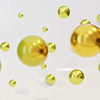| Nov 19, 2025 |
Trace chloride alters gold surface chemistry by forming a short-lived covalent layer of chloride ions on gold atoms.
(Nanowerk News) Cambridge researchers have uncovered a hidden layer of chemistry on gold nanoparticle surfaces that could transform the way sensors, catalysts, and medical diagnostic devices are designed and used. Their discovery reveals how even trace amounts of chloride ions, such as those found in table salt, can fundamentally alter the behaviour of gold at the nanoscale, opening new avenues for more stable, reusable, and tuneable gold nanomaterials.
|
|
Gold nanoparticles are essential in a wide range of technologies and used in everything from COVID-19 test kits and cancer diagnostics to pollution sensors and green energy devices. Their power comes from how molecules interact and react on their surfaces. Yet, the specific surface processes that control this behaviour, especially the role of adsorbed ions, have remained poorly understood.
|
|
Now a research team led by the Cavendish Laboratory, in collaboration with the Universities of Warwick, Birmingham, Strathclyde and Imperial College London, has found that even the smallest traces of chloride can affect the surface chemistry of gold. The new findings, published in Nature Chemistry (“Transient Au–Cl adlayers modulate the surface chemistry of gold nanoparticles during redox reactions”), show that a layer of chloride ions covalently bonds with gold atoms, creating a fleeting but highly influential surface state.
|
 |
| Artist’s illustration of a Au-Cl layer getting ‘punctured’ on a nanoparticle surface. (Image: Sarah Sibug-Torres)
|
|
“We tend to think of chloride as an ordinary electrolyte, but it turns out to play an active role in shaping gold’s surface chemistry,” said PhD student Sarah Sibug-Torres, who carried out this research at the Cavendish Laboratory. “This Au-Cl layer forms dynamically in chloride-containing environments, acting like a switch that stabilises the surface and controls how molecules can interact with it. It helps explain why gold sometimes acts unpredictably and how we can now make that behaviour more reliable.”
|
|
The discovery that an Au-Cl layer stabilises gold surfaces before it reorganises helps explain long-standing puzzles in how gold nanoparticles form with such uniform sizes during chemical synthesis. “By revealing how chloride temporarily protects and then reshapes the gold surface, we link the mechanisms of gold nanoparticle growth, catalysis and sensor regeneration,” said Sibug-Torres.
|
|
The team used a powerful technique called surface-enhanced Raman spectroscopy (SERS) to watch gold atoms in real time. By shining light into tiny gaps between gold nanoparticles, SERS detects the vibrational fingerprints of chemical bonds, revealing how chemical reactions unfold on metal surfaces. The same principle makes SERS a powerful molecular sensing technology that can be used to detect trace analytes for medical diagnostics such as in COVID tests, and environmental monitoring.
|
|
In this study, the researchers used SERS to spot the formation of the Au-Cl layer and have found that it acts as a surfactant, protecting the surface from further interactions, until it is suddenly punctured and a runaway process strips it all back to solid gold.
|
|
The computational modelling, performed at the University of Warwick, demonstrated that salt modifies the surface charge of gold, leading to this change. “It is remarkable how small changes in the charge redistribution on the gold surface led to such large changes in its properties,” said Professor Hatef Sadeghi, who led the work at Warwick.
|
|
By identifying this key ingredient to obtain a stable and regenerable gold surface, the researchers can now address one of the key challenges in developing reliable and reusable SERS sensors, paving the way for more sustainable sensing technologies.
|
|
“SERS is very sensitive to nanoscale changes in the gold surface, so obtaining reliable signals for quantitative measurements has always been difficult,” said Sibug-Torres. “By developing a way to actively reshape and restabilise the gold surface, we can now achieve reproducible SERS measurements and develop sensors that can be reused many times.”
|
|
“What excites me most is that we have uncovered a missing piece of how gold really behaves at the atomic scale,” said Prof Jeremy Baumberg, Professor of NanoPhotonics at the Cavendish Laboratory, who led this research. “The Au-Cl adlayer changes how we think about some of the most fundamental processes involving gold, from catalysis to nanoparticle growth. Even a simple ion like chloride can shape nanoscale structure, reactivity, and stability in ways not fully appreciated.”
|
|
The researchers are now working on ways to control this special chloride layer, not just on gold but on other metals too such as palladium and platinum. The behaviour of gold with many ions appears extremely useful, giving new ways to improve sensors and catalysts. “Our goal is to unlock new possibilities for everything from medical diagnostics to green manufacturing, bringing us closer to a future where gold-based nanotechnologies are even more powerful and sustainable,” said Baumberg.
|


